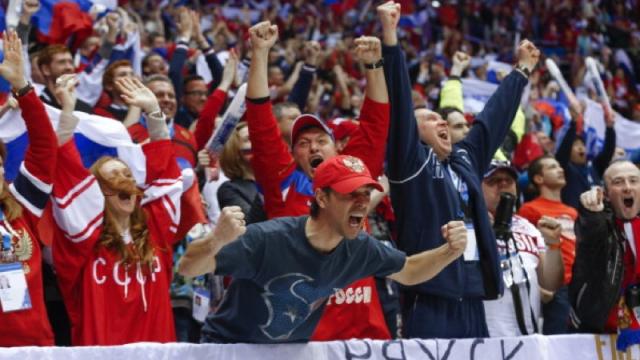Bad news, diehard sports fans: all that raucous cheering during games doesn’t really help your team win. The good news is that it doesn’t seem to interfere with players’ performance either.
That was the conclusion of Brenna Boyd, an undergraduate in architectural engineering at the University of Nebraska-Lincoln in Omaha. She presented measurements she made of noise levels at college football games this morning at the Acoustical Society of America meeting in Jacksonville, Florida. Boyd got the idea for her survey after hearing about an ongoing competition among college football fans as to which team has the loudest stadium. But she’s more of a hockey fan than a football fan, so she focused her own analysis on the noise levels in college hockey stadiums.
A sound wave’s amplitude, or range of movement, determines its volume. Pluck a guitar string very hard, and it will vibrate at the same frequency as when you pluck it softly, but the sound will be louder, because its amplitude is much greater. That string is moving back and forth over greater distance, so it exerts more more mechanical energy. The energy level (amplitude) of any sound is measured decibels (db). A human whisper is about 20 db, while normal conversation is around 60 db. Sound levels at a rock concert can reach 110 db. At 130 db, sound will cause pain and possibly damage the ear. The human eardrum will actually burst at 160 db.
The world record for the loudest crowd roar at a sporting event is currently held by the fans at Arrowhead Stadium, home to the Kansas City Chiefs. On 29 September 2014, the crowd’s roar hit a whopping 142 decibels. So just how loud do college football games get in comparison?

Michigan Technological University’s Andrew Barnard collected data on the noise levels during games, while still a grad student at Penn State. His analysis showed that when opposing teams had the ball during home games, the noise level in the university’s stadium hit 110 decibels — 50 times the volume as when Penn State was on offence — peaking at 122 decibels. (You can listen to sound samples here.)
Based on that analysis, Penn State moved the 20,000-seat student cheering section to the southern end zone, where their cheering would be amplified the most. The idea was to boost the fans’ excitement during games by reflecting more of that sound energy back into the stands and onto the field. But it also raised concerns about how well the quarterbacks would be able to communicate with their teammates and coaches given the ramped up noise level.
As sportswriter Sean Gregory noted in Time while covering the Seattle Seahawks in 2013, “Players have trouble hearing the quarterback’s instructions, which can cause delay-of-game penalties and generally throw an offence out of sync.” (Seattle’s Century Field held the previous world record for loudest crowd roar, helped by its unique canopy design, which amplifies the cheers.)
Boyd wondered about about the potential impact too. Most hockey stadiums have a built-in amplifying factor, since they have closed roofs and hence more surface area to reflect sound waves. So she hypothesized that they would be even louder than typically open-air football stadiums.
The loudest game Boyd measured was a match between Nebraska and arch-rival St. Cloud University: average loudness in the student section hit 95.5 decibels, peaking at about 132 decibels. For comparison, that’s the equivalent of jackhammer 15m away, and the sound of a jet engine about 30m away, respectively.
She also surveyed the players after each game to see whether all that cheering helped or hindered their play. The good news: most reported the noise wasn’t distracting, and it didn’t prevent clear communication between coaches or players during the game.
As for whether all that loud cheering helped the players — not so much. When Boyd matched up her loudness measurements with the events during the game, she found there wasn’t much correlation at all, for instance, between decibel level and how many goals the home team scored. Boyd thinks there wasn’t sufficient data to make a definitive case either way, however.
So go ahead and cheer your lungs out for the home team at live games. Just remember that it’s more psychologically satisfying to you than the players on the field. And maybe invest in a pair of ear plugs to protect your hearing, because those roaring crowds can get hella loud.
References:
Barnard, Andrew et al. (2008) “Noise levels during college football games and associated effects of players and fans,” Proc. of 2008 ASME NCAD Conference, NCAD2008-73012, Dearborn, MI.
Barnard, Andrew et al. (2011) “Evaluation of crowd noise levels during college football games,” Noise Control Eng. J. 59(6): 667-680.
Boyd, Brenna. “Measurements and player surveys of crowd noise levels during college hockey games,” Presentation at 170th meeting of the Acoustical Society of America, Session #1aNS7, November 2, 2015.
Top image: Fans cheer Men’s Ice Hockey Preliminary Rounds (USA vs. Russia) during 2014 Winter Olympic Games. Credit: Paul Drinkwater/NBC/NBCU Photo Bank via Getty Images. Bottom image: Andrew Barnard making sound measurements during a PSU game. Courtesy of Andrew Barnard.
